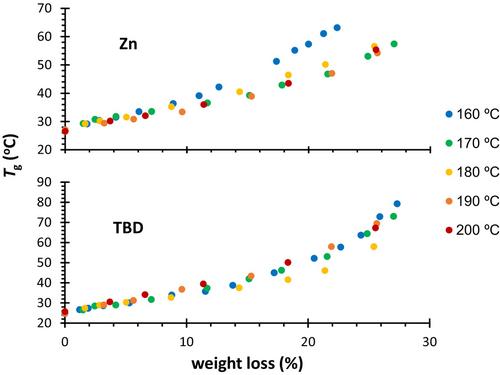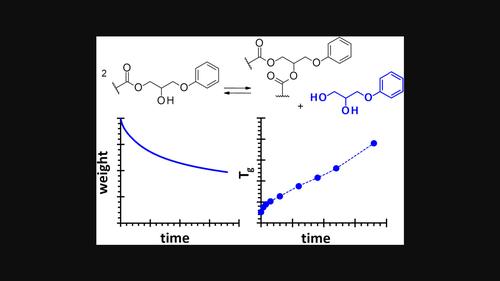Angelo Romano, Osman Konuray, Frida Román, Yolanda Calventus, Xavier Fernández-Francos, Ignazio Roppolo, Marco Sangermano
下载PDF
{"title":"Critical analysis of the thermal stability of transesterification vitrimers for 3D-printing applications based on digital light processing","authors":"Angelo Romano, Osman Konuray, Frida Román, Yolanda Calventus, Xavier Fernández-Francos, Ignazio Roppolo, Marco Sangermano","doi":"10.1002/pi.6592","DOIUrl":null,"url":null,"abstract":"<p>3D-printable vitrimers processed by digital light processing (DLP) have been recently developed, based on the transesterification reaction of <i>β</i>-hydroxyester structures from mono- and diacrylate monomers employed in the formulation. These materials show promising repairability and recyclability, in addition to other interesting features such as shape memory and shape reconfigurability. It has been reported that structural changes taking place due to transesterification promote network rearrangement and an enhancement of the thermomechanical properties. However, the elevated temperatures required for the network reconfiguration cast some doubts on their applicability in real-life scenarios. In this paper, we analyze the effect of the thermal treatment on the thermomechanical properties and relaxation behavior of these materials and discuss the underlying mechanism explaining the observed changes. We identify some critical issues related to use of a monoacrylate containing <i>β</i>-hydroxyester moieties, and propose solutions to overcome the most relevant drawbacks. © 2023 The Authors. <i>Polymer International</i> published by John Wiley & Sons Ltd on behalf of Society of Industrial Chemistry.</p>","PeriodicalId":20404,"journal":{"name":"Polymer International","volume":"73 4","pages":"280-286"},"PeriodicalIF":2.9000,"publicationDate":"2023-11-17","publicationTypes":"Journal Article","fieldsOfStudy":null,"isOpenAccess":false,"openAccessPdf":"https://onlinelibrary.wiley.com/doi/epdf/10.1002/pi.6592","citationCount":"0","resultStr":null,"platform":"Semanticscholar","paperid":null,"PeriodicalName":"Polymer International","FirstCategoryId":"92","ListUrlMain":"https://onlinelibrary.wiley.com/doi/10.1002/pi.6592","RegionNum":4,"RegionCategory":"化学","ArticlePicture":[],"TitleCN":null,"AbstractTextCN":null,"PMCID":null,"EPubDate":"","PubModel":"","JCR":"Q2","JCRName":"POLYMER SCIENCE","Score":null,"Total":0}
引用次数: 0
引用
批量引用
Abstract
3D-printable vitrimers processed by digital light processing (DLP) have been recently developed, based on the transesterification reaction of β -hydroxyester structures from mono- and diacrylate monomers employed in the formulation. These materials show promising repairability and recyclability, in addition to other interesting features such as shape memory and shape reconfigurability. It has been reported that structural changes taking place due to transesterification promote network rearrangement and an enhancement of the thermomechanical properties. However, the elevated temperatures required for the network reconfiguration cast some doubts on their applicability in real-life scenarios. In this paper, we analyze the effect of the thermal treatment on the thermomechanical properties and relaxation behavior of these materials and discuss the underlying mechanism explaining the observed changes. We identify some critical issues related to use of a monoacrylate containing β -hydroxyester moieties, and propose solutions to overcome the most relevant drawbacks. © 2023 The Authors. Polymer International published by John Wiley & Sons Ltd on behalf of Society of Industrial Chemistry.
基于数字光处理的3d打印应用中酯交换玻璃体热稳定性的关键分析
通过数字光处理(DLP)处理的3d打印玻璃体最近被开发出来,基于在配方中使用的单丙烯酸酯和双丙烯酸酯单体的β-羟基酯结构的酯交换反应。这些材料显示出有希望的可修复性和可回收性,以及其他有趣的特性,如形状记忆和形状可重构性。据报道,由于酯交换作用而发生的结构变化促进了网络重排和热机械性能的增强。然而,网络重构所需的高温对其在现实场景中的适用性提出了一些质疑。在本文中,我们分析了热处理对这些材料的热力学性能和弛豫行为的影响,并讨论了解释观察到的变化的潜在机制。我们确定了与使用含有β-羟基酯部分的单丙烯酸酯相关的一些关键问题,并提出了克服最相关缺点的解决方案。©2023作者。聚合物国际出版的约翰威利&本公司代表工业化学学会。
本文章由计算机程序翻译,如有差异,请以英文原文为准。



 求助内容:
求助内容: 应助结果提醒方式:
应助结果提醒方式:


